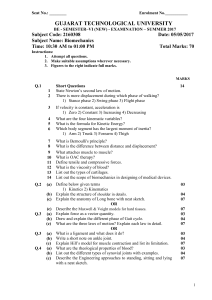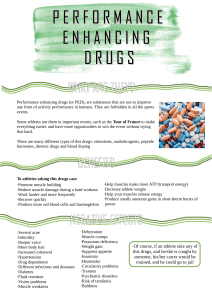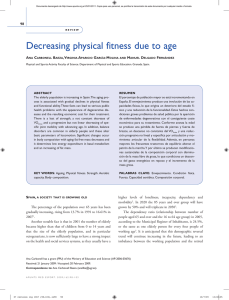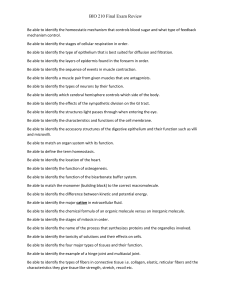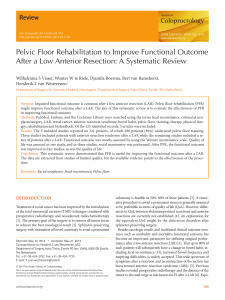Effect of Weight Training with Pelvic Floor Muscle Training in Elderly Women with Urinary Incontinence
Anuncio
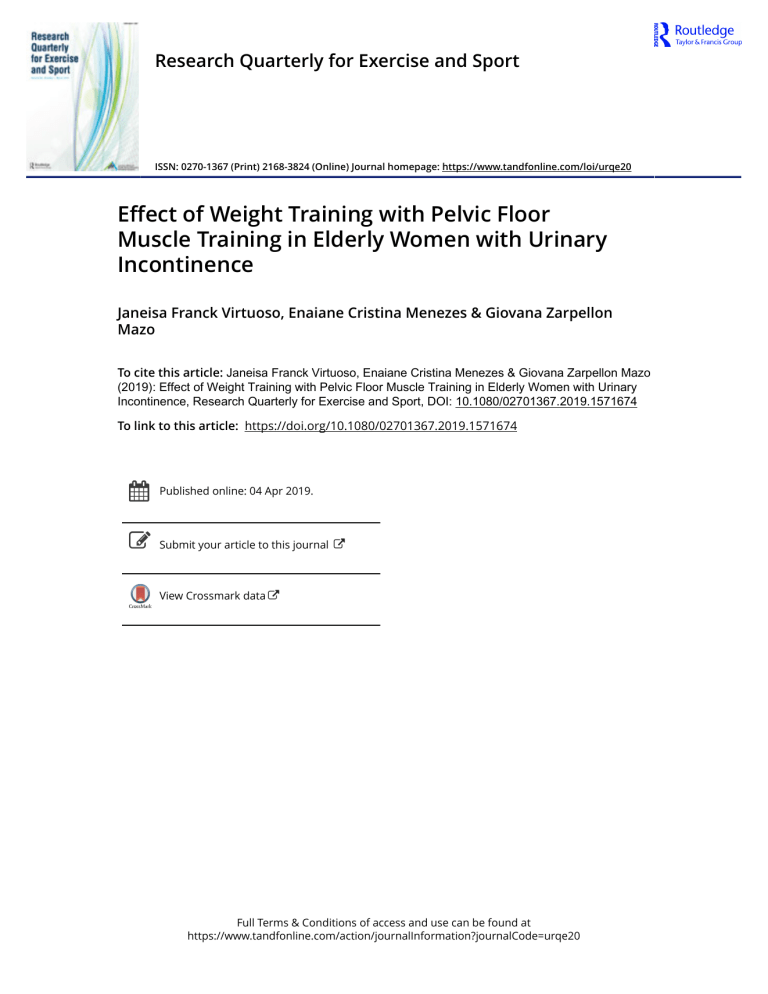
Research Quarterly for Exercise and Sport ISSN: 0270-1367 (Print) 2168-3824 (Online) Journal homepage: https://www.tandfonline.com/loi/urqe20 Effect of Weight Training with Pelvic Floor Muscle Training in Elderly Women with Urinary Incontinence Janeisa Franck Virtuoso, Enaiane Cristina Menezes & Giovana Zarpellon Mazo To cite this article: Janeisa Franck Virtuoso, Enaiane Cristina Menezes & Giovana Zarpellon Mazo (2019): Effect of Weight Training with Pelvic Floor Muscle Training in Elderly Women with Urinary Incontinence, Research Quarterly for Exercise and Sport, DOI: 10.1080/02701367.2019.1571674 To link to this article: https://doi.org/10.1080/02701367.2019.1571674 Published online: 04 Apr 2019. Submit your article to this journal View Crossmark data Full Terms & Conditions of access and use can be found at https://www.tandfonline.com/action/journalInformation?journalCode=urqe20 RESEARCH QUARTERLY FOR EXERCISE AND SPORT https://doi.org/10.1080/02701367.2019.1571674 Effect of Weight Training with Pelvic Floor Muscle Training in Elderly Women with Urinary Incontinence Janeisa Franck Virtuosoa, Enaiane Cristina Menezesb, and Giovana Zarpellon Mazob a Federal University of Santa Catarina; bState University of Santa Catarina ARTICLE HISTORY ABSTRACT Purpose: To determine if weight training combined with pelvic floor muscle training is more efficient than pelvic floor muscle training alone for the treatment of urinary incontinence (UI) symptoms in elderly women. Method: This was a two-arm, parallel, randomized controlled trial. Twenty-six women with stress UI participated in the study. The intervention group (IG) underwent training with moderate intensity weights combined with pelvic floor muscle training, whereas the control group (CG) only underwent pelvic floor muscle training. Intervention occurred twice a week over 12 weeks. The International Consultation on Incontinence Questionnaire–Short Form was used as the main measure. Scores of zero defined the absence of symptoms. The absence of symptoms was evaluated at 4 weeks, 12 weeks, and 1 month after the end of treatment. Moreover, activities related to UI and the use and change of daily protection were investigated. Results: The rate of absence of symptoms was significantly higher in IG after 4 weeks (58.3%) compared to CG (14.8%). The relative risk was 4.1 (95% confidence interval [CI] [1.08, 16.06]). Although no intention-to-treat analysis was performed, there was no difference in the evaluations after the interventions. Conclusion: Compared to pelvic floor muscle training alone, the combination of weight training and pelvic floor muscle training provided earlier improvement of UI in elderly women. Urinary incontinence (UI) causes a series of negative effects on the quality of life of women (Elbiss, Osman, & Hammad, 2013). The prevalence of this dysfunction is 36.3% (Marques, Schneider, Giehl, Antes, & D’Orsi, 2015). Randomized clinical trials have demonstrated the efficacy of pelvic floor muscle training (PFMT) in improving UI (Kashanian, Ali, Nazemi, & Bahasadri, 2011; Sherburn, Bird, Carey, Bø, & Galea, 2011). A systematic review conducted by Dumoulin and HaySmith (2010) concluded that PFMT provides better results than nontreatment or placebo treatments, especially in people with stress UI. In clinical trials using PFMT combined with physical exercise (thigh, abdominal, and back training), 55.4% of elderly women reported cure of UI (Kim, Suzuki, Yoshida, & Yoshida, 2007) after 3 months of training. In addition, a reduction in UI episodes and improvement in walking speed were reported (Kim, Yoshida, & Suzuki, 2011a). On the other hand, few clinical trials have submitted elderly women with UI to weight training (WT) and they used similar interventions based on strengthening of some muscle groups, such as the Received 6 October 2017 Accepted 3 January 2019 KEYWORDS Clinical trial; exercise; rehabilitation; resistance training abdominal, flexor, and knee extensor muscles (Kim et al., 2007; Kim, Yoshida, & Suzuki, 2011b; Kim et al., 2011a). However, these studies did not provide detailed descriptions of systematization and planning of such interventions, such as number of sets, repetitions, and weights used, impairing replication in clinical practice. The rationale would be that a multidimensional WT program will lead to cocontraction of the PFM (Bø, 2004) and improve muscle volume. Moreover, for the elderly, there is scientific evidence that WT improves cardiovascular health and physical fitness (Gurjão et al., 2012; Raymond, Bramley-Tzerefos, Jeffs, Winter, & Holland, 2013). Furthermore, WT is a safe and efficient strategy for the maintenance and development of muscle strength in women (Gurjão et al., 2012). Therefore, considering the high prevalence of UI in the elderly population (Elbiss et al., 2013; Marques et al., 2015) and the importance of promoting WT programs that improve UI, the aim of this study was to compare the effect of WT combined with PFMT and PFMT alone in elderly women with UI symptoms. CONTACT Janeisa Franck Virtuoso [email protected] Department of Physiotherapy, Federal University of Santa Catarina, Rua Gov. Jorge Lacerda, 3201, Urussanguinha, Araranguá-SC CEP: 88905-355, Brazil Trial registration: Brazilian Registry of Clinical Trials UTN: U1111-1149-2398. http://www.ensaiosclinicos.gov.br/ Color versions of one or more of the figures in the article can be found online at www.tandfonline.com/urqe. © 2019 SHAPE America 2 J. F. VIRTUOSO ET AL. The specific research question for this clinical trial was, “Is WT combined with PFMT more effective than PFMT alone for the treatment of UI symptoms in elderly women?” The physiotherapist who conducted the PFMT sessions with the IG and CG had 7 years of experience in UI physiotherapy. The researcher who conducted the WT sessions with the IG had 3 years of experience in teaching WT for older adults. Methods Design, participants, and therapists Intervention This was a randomized clinical trial conducted in Florianópolis, Brazil, between August 2013 and January 2015. The trial was registered in the Brazilian Registry of Clinical Trials (REBEC) (UTN: U1111-11492398, http://www.ensaiosclinicos.gov.br/rg/RBR-85qvn9/ ). The Ethics Committee of the State University of Santa Catarina (UDESC) approved this study under number 498.443, and written informed consent was obtained from the participants. The study lasted 12 weeks, with two sessions per week. The sample was divided into an intervention group (IG; n = 14) and a control group (CG; n = 18). The IG underwent PFMT combined with WT, whereas the CG underwent only PFMT. This study included women age ˃ 60 years, recruited in the community, who experienced clinical UI symptoms during coughing, sneezing, or other physical activities (stress incontinence) and two or three episodes of UI per week. The muscle and pelvic floor strength of the participants was ≥ 2 according to the Oxford scale (Laycock & Jerwood, 2001), and their cognitive function was preserved (Brucki, Nitrin, Caramelli, Bertolucci, & Okamoto, 2003). Exclusion criteria were: physiotherapy treatment for symptoms of recent UI (< 6 months ago), urgent UI resulting from neurological causes, presence of symptoms of urinary tract infection, participation in WT in the past 6 months, and diseases with contraindications for WT. To guarantee a similar number of elderly women and randomization by stage in IG and CG, randomization was performed in groups of 10 participants. For this purpose, an external researcher generated a computerized sequence of random numbers and the woman was allocated to IG or CG according to her order of participation in the study. This randomization was carried out after assessment of the patient, which was a blind assessment. The external researcher told the participants about the importance of keeping the WT part confidential, as the physiotherapist who conducted PFMT also assessed the participants. It should be noted that the evaluator did not know which participants belonged to the IG. The study design is shown in Figure 1. Pelvic floor muscle training in the intervention and control groups The PFMT protocol was based on the recommendations proposed by Bo, Talseth, and Holme (1999) and Choi, Palmer, and Park (2007). The sessions were conducted twice a week for approximately 30 minutes per session. Each group was composed of a maximum of six women. The intervention consisted of three exercises in different positions: lying down, sitting, and standing. The exercises proposed by da Luz (2011) were used (Appendix). Each exercise comprised eight to 12 repetitions of PFMT. The verbal command for PFM contraction was “hold pee,” which was performed during expiration. After eight sessions, the “knack” maneuver was used during sessions. The progression of PFMT over a period of 3 months (12 weeks) is shown in Figure 2. All participants were encouraged to execute this series of PFM contractions at home. Adherence to home exercises was measured by asking, “How frequently did you follow the guidelines for pelvic floor muscle contractions in your home?” (0 = not at all and 10 = followed completely). An informative banner about correct PFM contraction, the importance of exercising at home (at least 30 contractions), and keeping the WT status private was placed at the training facility. Weight training in the intervention group Immediately after the PFMT sessions, the IG participants were taught WT. The WT protocol was based on the American College of Sports Medicine’s program (American College of Sports Medicine et al., 2009). The WT program was carried out for 12 weeks and comprised two weekly sessions of 50 minutes per session. The training consisted of 15 repetitions maximum (RM), with a oneminute interval between sets. The exercises were performed in an alternating order, starting with the largest muscle groups. The WT protocol was divided into three stages: familiarization stage, weight determination, and training sessions. Protocol details can be found in the Appendix. To remind participants in the study about PFM contraction during muscle exercises, an informative banner was placed at the facility where WT was carried out. These RESEARCH QUARTERLY FOR EXERCISE AND SPORT 3 UI women who sought treatment (n = 99) Exclusion criteria (n = 67) Women referred to the study – Randomization (n = 32) Intervention Group (n = 14) Day 0 Losses Inguinal hernia (n = 1) Transport problem (n = 1) Control Group (n = 18) Intervention: PFMT twice a week plus WT Intervention: PFMT twice a week Losses Familial problem (n = 1) Laziness (n = 1) Transport problem (n = 1) Desmotivation (n = 1) Assessment of urinary loss 4 weeks Intervention Group (n = 12) Control Group (n = 14) Intervention: PFMT twice a week plus WT Intervention: PFMT twice a week Assessment of urinary loss 12 weeks Intervention Group (n = 12) Control Group (n = 14) Assessment of urinary loss 1-month follow-up Intervention Group (n = 12) Control Group (n = 14) Figure 1. Design and flow of participants in the trial. contractions were encouraged because this was the first clinical trial using WT for the treatment of IU to avoid adverse effects of increased intrabdominal pressure. Outcome measures The participants were interviewed, and information about sociodemographic data and UI risk factors in elderly women was recorded (Bø, 2004; Virtuoso, Menezes, & Mazo, 2015). Body mass was determined with a digital scale and stature was measured with a stadiometer. The body mass index was calculated dividing body mass (kg) by the squared height of the participant (m2). The waist circumference (cm) was measured at the midpoint between the lower border of the last rib and the iliac crest using a round 1.50-m tape measure. 4 J. F. VIRTUOSO ET AL. Start of treatment After eight weeks • Six-second sustained contractions, plus three fast contractions. After 16 weeks • Eight-second sustained contractions, plus four fast contractions. • Knack Maneuver. • Ten-second sustained contractions, plus five fast contractions. • Knack Maneuver. Figure 2. Progression of pelvic floor muscle training. Urinary incontinence The International Consultation on Incontinence Questionnaire–Short Form (ICIQ-SF) was developed by Avery et al. (2004) and was translated, adapted, and validated for Brazil by Tamanini, Dambros, D’Ancona, Palma, and Rodrigues Netto (2004). Its aim is to assess the impact of UI on quality of life and to qualify UI. This questionnaire evaluates the frequency of UI, the amount of incontinence, and how much these parameters interfere with a person’s daily life. These items yield the final quality of life score. and effect size was calculated using Cohen’s d. A 95% CI was used. A 40% difference in the absence of symptoms rate between groups indicated a clinically important difference. The calculations assumed a two-sided effect, with alpha of 0.05 and power of 80.0%. A total sample size of 21 women was calculated. Assuming a dropout rate of 20.0%, the desired sample size at enrollment was 26 women. No intention-to-treat analysis was performed in this study. Results Severity of symptoms To identify UI severity, an interview form including questions about length of UI symptoms (in years), use of daily sanitary pads, number of daytime and nocturnal changes of sanitary pads, and episodes of UI was applied. Data analysis All collected variables were analyzed descriptively. The Shapiro-Wilk test was used to assess the normality of the data. Depending on the distribution of the data, the paired t test or Wilcoxon test was used for intragroup comparison and the t test for independent samples or Mann-Whitney U test for intergroup comparison. A level of significance of 5% was adopted. The measures used to compare the two interventions were the relative risk (RR) and the number needed to treat (NNT) for the absence of symptoms (dichotomized outcome). The numerical outcome was determined as the difference between mean ICIQ-SF scores In this study, 32 elderly women were randomized, 14 to the IG and 18 to the CG. Some sample losses occurred during the clinical trial. As can be seen in Figure 1, 12 women in IG (85.7%) and 14 in CG (77.8%) completed the study. The dropout rate was 14.3% and 22.2%, respectively. The participants in IG had a mean age of 64.8 ± 4.7 years; most women were married (75.0%), had 11 years of schooling (83.3%), and a household income of more than six Brazilian minimum wages (> R$ 4068.00; 75.0%). The participants in CG had a mean age of 66.5 ± 5.5 years; most women were married (57.1%), had 5 to 8 years of schooling (50.0%), and a household income of more than six Brazilian minimum wages (> R$ 4068.00; 35.7%) or between three and four minimum wages (R$ 2034.00–R$ 2712.00; 28.6%). In addition to activity-related UI symptoms (stress incontinence), most elderly women of IG (66.7%) and CG (57.1%) displayed UI associated with urinary urgency. Table 1 shows the comparison of some risk factors for UI development and severity measures between IG RESEARCH QUARTERLY FOR EXERCISE AND SPORT 5 Table 1. Comparison of risk factors for urinary incontinence (UI) development and severity measurements between elderly women of intervention group (IG; n = 12), and control group (CG; n = 14) at baseline. Risk Factors and Severity Measurements Menopause time years; Mean ± SD Normal birth number; median (IQR) Arterial hypertension presence; n (%) Diabetes presence; n (%) Constipation presence; n (%) Regular physical activity presence; n (%) Family history presence; n (%) Body Mass Index kg/m2; Mean ± SD Waist circumference cm; Mean ± SD UI time years; Mean ± SD Activities causing incontinence yes; n (%) Sneezing Coughing Laughing Jumping Weight lifting Running Daily protection use number; n (%) Always Occasionally Never Daily protection changes number; median (IQR) Nocturnal protection changes number; median Intervention Group Control Group p value 14.5 ± 8.4 0.5 (3.0) 6 (50.0) 2 (16.7) 5 (41.7) 10 (83.3) 8 (66.7) 30.3 ± 4.5 93.9 ± 8.5 4.7 ± 3.5 17.9 ± 7.7 2.0 (3.0) 9 (64.3) 2 (14.3) 2 (14.3) 7 (50.0) 9 (64.3) 28.8 ± 4.7 91.1 ± 9.1 10.3 ± 11.9 0.176 0.347 0.462 0.578 0.246 0.085 0.613 0.728 0.689 0.631 12 12 9 6 5 5 14 (100.0) 14 (100.0) 12 (85.7) 9 (64.3) 6 (42.9) 8 (57.1) 1.000 1.000 0.422 0.462 0.951 0.431 7 (50.0) 5 (35.7) 2 (14.3) 1.5 (2) 0.0 (1) 0.140 (100.0) (100.0) (75.0) (50.0) (41.7) (41.7) 2 (18.2) 5 (45.5) 4 (36.4) 0.5 (2) 0.0 (1) (IQR) 0.118 0.527 Note: Subscript texts represent the units of the variable; when a numerical variable, it can be expressed in median and amplitude, or mean and standard deviation, or n and % for categorical variables. IQR = interquartile range; n = absolute frequency; % = relative frequency. and CG before the beginning of this study. The data suggested that both groups were similar (p > .05) in terms of risk factors and severity measures. Figure 3 shows a reduction in the ICIQ-SF score in both groups at the end of the intervention (p < .001). These finding indicate a decrease in the frequency and amount of UI and an impact on the quality of life of elderly women. The reduction in mean ICIQ-SF score between pre- and postintervention was greater in CG (9.1 ± 5.0) than in IG (8.0 ± 5.6), but this difference was not significant (t = −0.875, p = .390, d = .215). The rate of absence of symptoms of UI was 58.3% in IG, whereas this rate was 14.3% in CG (Figure 4). 18.0 (11.11–15.18) 16.0 14.0 * d = 2.42 * d = 2.53 13.14 (8.49–11.51) 12.0 10.0 10.0 (1.88–6.26) 8.0 (–0.41–4.41) 6.0 4.1 4.0 2.0 2.0 0.0 Intervention Group ICIQ pretest Control Group ICIQ post test Figure 3. Comparison between pre- and postvalues measured using International Consultation on Incontinence Questionnaire–Short time in the intervention group and control group. *p < .001. A significant association was observed between group and the absence of symptoms after 4 weeks (χ2 = 5.539, p = .025), suggesting that PFMT combined with WT leads to earlier improvement in symptoms as observed in IG. In addition, the RR indicated a 4.1 times greater rate of absence of symptoms in the first 4 weeks of intervention in the group undergoing PFMT combined with WT compared to women undergoing only PFMT (RR = 4.1, 95% CI [1.08, 16.06]). The NNT was two (95% CI [1.0, 14.0]), suggesting that one in two women with UI undergoing PFMT combined with WT achieve complete reduction of symptoms within a month. The absence of symptoms rate after the end of treatment was 75.0% in IG and 35.7% in CG (χ2 = 4.013, p = .05) (Figure 4). Although this rate was higher in GI, the RR indicated that this association was not significant (RR = 2.14, 95% CI [0.97, 4.55]). As shown in Figure 4, the absence of symptoms rate one month after the end of treatment was 83.3% in IG, whereas it was 50.0% in CG (χ2 = 3.172, p = .085). There was no association between absence of symptoms and group (RR = 1.68, 95% CI [0.93, 3.00]) at this time point. Figure 5 shows a decrease in the most frequent situations causing incontinence, such as sneezing, coughing, and laughing, at the end of treatment in both groups. Moreover, improvement during running and jumping activities was observed in CG (p < .05). Comparison of the proportions of improvement indicated no significant difference between IG and CG (p > .05). 6 J. F. VIRTUOSO ET AL. X² = 5.539 p = .025 100.0 80.0 41.7 85.7 60.0 40.0 (a) 58.3 20.0 14.3 0.0 Intervention Group Absence of symptoms 100.0 Control Group Presence of symptoms X² = 4.013 p = .05 25.0 80.0 64.3 (b) 60.0 40.0 75.0 35.7 20.0 0.0 Intervention Group Absence of symptoms 100 confirm that both groups adhered similarly to the proposed guidelines (p =.860). Control Group Presence of symptoms X² = 3.172 p = .085 16.7 50.0 80 (c) 60 83.3 40 50.0 20 0 Intervention Group Absence of symptoms Control Group Presence of symptoms Figure 4. Association between occurrence of cure of urinary incontinence symptoms in the intervention group and control group after 4 weeks (a) and 12 weeks of treatment (b), and 1-month follow-up (c). Note. χ2 = chi-square test statistics; p = significance level. Regarding the use of daily protections (Table 2) measured only at the end of treatment, intragroup comparison showed a higher median number of daily changes in CG (p = .046), whereas there was a decrease in the number of nocturnal changes in IG (p = .007). No difference in the use of sanitary pads (paper/cloth) or daily changes was observed between groups. The median adherence to home exercises was 9 (3–10) in IG and 8 (4–10) in CG. These findings Discussion This trial compared the effects of WT combined with PFMT and PFMT alone on improving incontinence in elderly women with UI. The working hypothesis was that intervention with WT combined with PMFT is better than the use of PFMT alone. The results indicated a higher rate of absence of symptoms and earlier recovery among IG women, as well as higher absence of symptoms rates in the first 4 weeks of intervention, compared to CG women. PFMT is reported in the literature as the best conservative treatment for activity-related UI (Dumoulin & Hay-Smith, 2010). According to Choi et al. (2007), the effects are even better in younger women (< 60 years). However, Davison and Moore (2013) suggested that PFMT is also beneficial for the elderly population. This training alleviates symptoms and increases PFM strength. This information was confirmed in this study in which the CG had significantly lower ICIQ-SF scores after PFMT. Although no significant difference in ICIQ-SF scores was observed between groups, the rate of absence of symptoms, defined as a score of zero using this tool, was greater among women at the end of treatment with WT and PFMT (75.0%) compared to those who only underwent PFMT (35.7%). As reported by Grewar and McLean (2008), motor control, musculoskeletal, and behavioral factors are thought to be modifiable and may influence the function of the urinary continence system. Consequently, reflex PFM contraction is believed to occur (Bø, 2004) as soon as the intra-abdominal pressure during physical exercise increases. This co-contraction may explain the higher rate of absence of symptoms among IG women. Furthermore, a higher rate of absence of symptoms was observed in IG after 4 weeks of intervention (58.3%). This earlier recovery may be explained by the overlap of treatments resulting in an extra stimulus for PFM contraction, though it has been shown that conventional WT protocols do not stimulate contraction of this musculature. PFMT causes morphological and functional changes in PFM, in addition to the improvement of UI symptoms (Braekken et al., 2010). The training proposed in that study consisted of one session per week for 3 months and one session every 2 weeks for 3 months, totaling 6 months of treatment. The sessions comprised RESEARCH QUARTERLY FOR EXERCISE AND SPORT 7 8.3 Run 41.7 Posttest Pretest 8.3 Lift weight 41.7 (a) 8.3 Jump 50.0 8.3 * Laugh 75.0 16.7 * Cough 100.0 16.7 * Sneeze 100.0 0.0 10.0 20.0 40.0 50.0 60.0 70.0 80.0 90.0 100.0 7.7 * Run 57.1 (b) 14.3 Lift weight 42.9 15.4 * Jump Laugh 30.0 64.3 0.0 * 85.7 15.4 * Cough 100.0 30.8 * Sneeze 100.0 0.0 10.0 20.0 30.0 40.0 50.0 60.0 70.0 80.0 90.0 100.0 Figure 5. Comparison between pre- and postintervention in the intervention group (a) and control group (b) regarding urinary loss situation proportions. Note. *p < .05. Table 2. Comparison of use of sanitary napkins (paper/cloth) and number of their changes between elderly women in the intervention group (IG; n = 12) and control group (CG; n = 14). Use of sanitary pads Never wears protection n (%) Pre Post p¥ Daily changes median (minimum- Intervention Group (IG) Control Group (CG) 5 (41.7) 8 (66.7) 0.412 2 (15.4) 6 (46.2) 0.202 0.530 0.5 (0–5) 0.0 (0–2) 0.334 1.5 (0–7) 0.5 (0–2) 0.046* 0.457 0.0 (0–2) 0.0 (0–1) 0.007* 0.0 (0–1) 0.0 (0–1) 0.180 0.705’ p§ maximum) Pre Post p¥ Nocturnal changes median (minimum- maximum) Pre Post p¥ Note: Subscript texts represent the units of the variable; when a numerical variable, it can be expressed in median and amplitude, or mean and standard deviation, or n and % for categorical variables. n = absolute frequency; % = relative frequency; p ¥ = intragroup significance level; p § = intergroup significance level (post). *p < .05. three sets of eight to 12 maximum contractions of the pelvic floor lying down, sitting, and standing. The authors found a significant increase in pubovisceral muscles, a decrease in the urogenital hiatus, and a reduction in muscle length among women who underwent PFMT. These anatomical changes make it possible for two urinary continence mechanisms to work: increase in urethral closing pressure at rest and increase in urethral closing pressure during increased intraabdominal pressure (Delancey & Ashton-Miller, 2004). Thus, the anatomical changes in PFM after PFMT may explain the improvement of activityrelated (stress) UI in both groups and the earlier improvement observed in IG. The American College of Sports Medicine (ACSM et al., 2009) recommends 60% to 80% of eight to 12 RM in older adults for strength gain and hypertrophy. However, progressive resistance training with sets of 15 RM also provides strength gains in the elderly (Harris, DeBeliso, Spitzer-Gibson, & Adams, 2004). Accordingly, it is possible to build strength by increasing the weight within a prescribed zone, as was done in this study in which moderate intensity was used, with a 15 RM recommended zone. This demonstrates the importance of integral physiotherapy treatment, which provides interventions that improve different aspects of health. This type of physical exercise is considered a protection 8 J. F. VIRTUOSO ET AL. factor against UI as it improves strength and general health, increases muscle strength, and reduces body weight, the occurrence of stress UI and pelvic organ prolapse (Nygaard, Shaw, & Egger, 2012). Improvement of some muscular parameters was observed in a study involving older adults participating in only 6 weeks of weight training (Scanlon et al., 2014). There was improvement of 32.0% in muscle strength, 31.0% in muscle quality, and 7.4% in vastus lateralis. Positive shortterm changes were also observed in the present study in which the rate of absence of symptoms was higher among women in IG. The combination of WT and PFMT resulted in earlier improvement of symptoms within 4 weeks. However, although the short-term efficacy of a health strategy is key in clinical practice, the response may not persist if the intervention is ended prematurely. Further research is necessary to clarify the innovative proposal of this study. The follow-up period of this study was short (1 month). However, as the rate of absence of UI symptoms increased in both groups (IG and CG), the effects of PFMT seem to have been constant during that period. Long-term recurrence of UI is common and was identified in the study by Beyar and Groutz (2017) in which almost all women reported UI 5 years after PFMT, though 41.7% had adhered to the exercises during that period. A study indicated a 40% relapse rate of UI per year after physiotherapy treatment (Krüger, Luz, & Virtuoso, 2011) and a significant association between the absence of UI symptoms and performing exercises at home twice a week or more (p = .001). In a systematic review, Bø and Hilde (2013) evaluated long-term outcomes of PFMT in female UI. As stated by the authors, long-term adherence varies from 10% to 70%, but levels of PFMT and follow-up strategies are different across studies. Such findings reiterate the need for maintaining PFM exercises at home after the end of treatment. Moreover, physiotherapists should design strategies based on theories that would help women remember such exercises (Borello-France et al., 2010; Sacomori, Berghmans, Mesters, de Bie, & Cardoso, 2015). Study limitations This study has some limitations such as the lack of blinding of the patients and the subjective assessment of UI. Although urodynamic examination is the gold standard for determining the type of UI, this bias was reduced by using an international validated tool (ICIQ-SF) that assesses the frequency and severity of symptoms. Additionally, in clinical practice, the use of this tool is easier and less expensive than urodynamic examination. What does this article add? The current knowledge about the relationship between physical exercise and the management of urinary incontinence is still conflicting. The type and intensity of exercise have a bidirectional relationship (negative and positive), influencing the symptoms of urinary loss (Nygaard et al., 2012). This article reports an innovative proposal for the interdisciplinary treatment of urinary incontinence in older adults using weight training at moderate intensity (extremely important for the elderly) and physical therapy (pelvic floor muscle training). The constantly growing elderly population is known to increase healthcare costs. Thus, strategies designed to rapidly and efficiently improve symptoms are necessary, especially in the case of UI, which is associated with worsening quality of life, social isolation and depression. This study provides physical education, physical therapy, and urogynecology professionals with an interdisciplinary and global approach to the care of older women with urinary incontinence aimed at short-term treatment. Acknowledgments Government of Santa Catarina State (FUMDES scholarship) and CNPq for grant productivity to GZM. Funding This research was funded by the Government of Santa Catarina State (FUMDES scholarship), the Coordination for the Improvement of Higher Education Personnel (CAPES scholarship), and a National Council for Scientific and Technological Development (CNPq) productivity grant to Giovana Zarpellon Mazo. References American College of Sports Medicine, Chodzko-Zajko, W. J., Proctor, D. N., Fiatarone Singh, M. A., Minson, C. T., Nigg, C. R., & Skinner, J. S. (2009). American College of Sports Medicine position stand. Exercise and physical activity for older adults. Medicine and Science in Sports and Exercise, 41(7), 1510–1530. Avery, K., Donovan, J., Peters, T. J., Shaw, C., Gotoh, M., & Abrams, P. (2004). ICIQ: A brief and robust measure for evaluating the symptoms and impact of urinary incontinence. Neurourology and Urodynamics, 23(4), 322–330. doi:10.1002/nau.20041 Beyar, N., & Groutz, A. (2017). Pelvic floor muscle training for female stress urinary incontinence: Five years outcomes. Neurourology and Urodynamics, 36(1), 132–135. doi:10.1002/nau.22888 Bø, K. (2004). Urinary incontinence, pelvic floor dysfunction, exercise and sport. Sports Medicine (Auckland, N.Z.), 34 (7), 451–464. doi:10.2165/00007256-200434070-00004 RESEARCH QUARTERLY FOR EXERCISE AND SPORT Bø, K., & Hilde, G. (2013). Does it work in the long term?-A systematic review on pelvic floor muscle training for female stress urinary incontinence. Neurourology and Urodynamics, 32(3), 215–223. doi:10.1002/nau.22292 Bo, K., Talseth, T., & Holme, I. (1999). Single blind, randomised controlled trial of pelvic floor exercises, electrical stimulation, vaginal cones, and no treatment in management of genuine stress incontinence in women. BMJ, 318 (7182), 487–493. doi:10.1136/bmj.318.7182.487 Borello-France, D., Burgio, K. L., Goode, P. S., Markland, A. D., Kenton, K., Balasubramanyam, A., & Stoddard, A. M. (2010). Adherence to behavioral interventions for urge incontinence when combined with drug therapy: Adherence rates, barriers, and predictors. Physical Therapy, 90(10), 1493–1505. doi:10.2522/ptj.20080387 Braekken, I. H., Hoff Braekken, I., Majida, M., Engh, M. E., Bø, K., & Bo, K. (2010). Morphological changes after pelvic floor muscle training measured by 3-dimensional ultrasonography: A randomized controlled trial. Obstetrics and Gynecology, 115(2 Pt 1), 317–324. doi:10.1097/ AOG.0b013e3181cbd35f Brucki, S. M. D., Nitrin, R., Caramelli, P., Bertolucci, P. H. F., & Okamoto, I. H. (2003). Sugestões para o uso do miniexame do estado mental no Brasil. Arquivos de NeuroPsiquiatria, 61(3B), 777–781. doi:10.1590/S0004282X2003000500014 Choi, H., Palmer, M. H., & Park, J. (2007). Meta-analysis of pelvic floor muscle training. Nursing Research, 56(4), 226–234. doi:10.1097/01.NNR.0000280610.93373.e1 da Luz, S. C. T. (2011). Educação Perineal Progressiva EPP em busca da continência urinária (Biblioteca). São Paulo, Brazil: Biblioteca 24 horas. Davison, J. E., & Moore, K. (2013). Pelvic floor muscle training for urinary incontinence in older adults: A systematic review. Australian and New Zealand Continence Journal, 19(1), 18–26. Delancey, J. O. L., & Ashton-Miller, J. A. (2004). Pathophysiology of adult urinary incontinence. Gastroenterology, 126(Suppl. 1), S23–S32. doi:10.1053/j.gastro.2003.10.080 Dumoulin, C., & Hay-Smith, J. (2010). Pelvic floor muscle training versus no treatment, or inactive control treatments, for urinary incontinence in women. Cochrane Database of Systematic Reviews, 20(1). doi:10.1002/ 14651858.CD005654.pub2 Elbiss, H. M., Osman, N., & Hammad, F. T. (2013). Social impact and healthcare-seeking behavior among women with urinary incontinence in the United Arab Emirates. International Journal of Gynecology & Obstetrics, 122(2), 136–139. doi:10.1016/j.ijgo.2013.03.023 Grewar, H., & McLean, L. (2008). The integrated continence system: A manual therapy approach to the treatment of stress urinary incontinence. Manual Therapy, 13(5), 375–386. doi:10.1016/j.math.2008.01.003 Gurjão, A. L. D., Gobbi, L. T. B., Carneiro, N. H., Gonçalves, R., Ferreira de Moura, R., Cyrino, E. S., … Gobbi, S. (2012). Effect of strength training on rate of force development in older women. Research Quarterly for Exercise and Sport, 83(2), 268–275. doi:10.1080/ 02701367.2012.10599857 Harris, C., DeBeliso, M. A., Spitzer-Gibson, T. A., & Adams, K. J. (2004). The effect of resistance-training intensity on strength-gain response in the older adult. The 9 Journal of Strength and Conditioning Research, 18(4), 833. doi:10.1519/14758.1 Kashanian, M., Ali, S. S., Nazemi, M., & Bahasadri, S. (2011). Evaluation of the effect of pelvic floor muscle training (PFMT or Kegel exercise) and assisted pelvic floor muscle training (APFMT) by a resistance device (Kegelmaster device) on the urinary incontinence in women “comparison between them: A randomized tri. European Journal of Obstetrics & Gynecology and Reproductive Biology, 159(1), 218–223. doi:10.1016/j.ejogrb.2011.06.037 Kim, H., Suzuki, T., Yoshida, Y., & Yoshida, H. (2007). Effectiveness of multidimensional exercises for the treatment of stress urinary incontinence in elderly community-dwelling Japanese Women: A randomized, controlled, crossover trial. Journal of the American Geriatrics Society, 55(12), 1932–1939. doi:10.1111/j.1532-5415.2007.01447.x Kim, H., Yoshida, H., & Suzuki, T. (2011a). The effects of multidimensional exercise on functional decline, urinary incontinence, and fear of falling in community-dwelling elderly women with multiple symptoms of geriatric syndrome: A randomized controlled and 6-month follow-up trial. Archives of Gerontology and Geriatrics, 52(1), 99–105. doi:10.1016/j.archger.2010.02.008 Kim, H., Yoshida, H., & Suzuki, T. (2011b). The effects of multidimensional exercise treatment on community-dwelling elderly Japanese women with stress, urge, and mixed urinary incontinence: A randomized controlled trial. International Journal of Nursing Studies, 48(10), 1165–1172. doi:10.1016/j. ijnurstu.2011.02.016 Krüger, A. P., Luz, S. C. T., & Virtuoso, J. F. (2011). Home exercises for pelvic floor in continent women one year after physical therapy treatment for urinary incontinence: An observational study. Revista Brasileira de Fisioterapia, 15(5), 351–356. doi:10.1590/S141335552011005000006 Laycock, J., & Jerwood, D. (2001). Pelvic floor muscle assessment: The PERFECT scheme. Physiotherapy, 87(12), 631–642. doi:10.1016/S0031-9406(05)61108-X Marques, L. P., Schneider, I. J. C., Giehl, M. W. C., Antes, D. L., & D’Orsi, E. (2015). Demographic, health conditions, and lifestyle factors associated with urinary incontinence in elderly from Florianópolis, Santa Catarina, Brazil. Revista Brasileira de Epidemiologia, 18(3), 595–606. doi:10.1590/1980-5497201500030006 Nygaard, I., Shaw, J., & Egger, M. J. (2012). Exploring the association between lifetime physical activity and pelvic floor disorders: Study and design challenges. Contemporary Clinical Trials, 33(4), 819–827. doi:10.1016/j.cct.2012.04.001 Raymond, M. J., Bramley-Tzerefos, R. E., Jeffs, K. J., Winter, A., & Holland, A. E. (2013). Systematic review of high-intensity progressive resistance strength training of the lower limb compared with other intensities of strength training in older adults. Archives of Physical Medicine and Rehabilitation, 94(8), 1458–1472. doi:10.1016/j.apmr.2013.02.022 Sacomori, C., Berghmans, B., Mesters, I., de Bie, R., & Cardoso, F. L. (2015). Strategies to enhance self-efficacy and adherence to home-based pelvic floor muscle exercises did not improve adherence in women with urinary incontinence: A randomised trial. Journal of Physiotherapy, 61(4), 190–198. doi:10.1016/j.jphys.2015.08.005 10 J. F. VIRTUOSO ET AL. The training sessions lasted 2 weeks. After this time, a new weight determination was performed. During the WT intervention period, three weight determinations were made. The muscle groups focused on during the weight training protocol were: Pectoral (Fly); Gluteus, Quadriceps, and Hamstrings (Leg Press 180º); Latissimus Dorsi (Closed Grip Seated Cable Row); Adductor (Adductor Chair); Triceps Brachii (Pulley Machine); Biceps Brachii (Pulley Machine); and Rectus Abdominis (Abdominal Crunch). During the exercises, pelvic floor muscle (PFM) contraction was initiated by the command “hold pee.” Contraction occurred during activity, between the initial and final positions of movement, and the concentric phase of exercise, and began after the seventh session, when the participants were familiar with the muscle exercise routines. WT exercises were performed using bodybuilding machines (Tonus Fitness Equipament®). Scanlon, T. C., Fragala, M. S., Stout, J. R., Emerson, N. S., Beyer, K. S., Oliveira, L. P., & Hoffman, J. R. (2014). Muscle architecture and strength: Adaptations to short-term resistance training in older adults. Muscle & Nerve, 49(4), 584–592. doi:10.1002/mus.23969 Sherburn, M., Bird, M., Carey, M., Bø, K., & Galea, M. P. (2011). Incontinence improves in older women after intensive pelvic floor muscle training: An assessor-blinded randomized controlled trial. Neurourol ogy and Urodynamics, 30(3), 317–324. doi:10.1002/ nau.20968 Tamanini, J. T. N., Dambros, M., D’Ancona, C. A. L., Palma, P. C. R., & Rodrigues Netto, N. (2004). Validation of the “International Consultation on Incontinence Questionnaire - Short Form” (ICIQ-SF) for Portuguese. Revista de Saúde Pública, 38(3), 438–444. doi:10.1590/S0034-89102004000300015 Virtuoso, J. F., Menezes, E. C., & Mazo, G. Z. (2015). Fatores de risco para incontinência urinária em mulheres idosas praticantes de exercícios físicos. Revista Brasileira de Ginecologia e Obstetrícia, 37(2), 82–86. doi:10.1590/SO100-720320140005040 Pelvic floor muscle training Appendix The pelvic floor muscle training (PFMT) protocol was conducted by a physiotherapist, who talked about urinary incontinence issues and clarified doubts during the beginning of the session. Then, PFMT exercises were done. The PFMT protocol of 24 sessions is described below, detailing the session topic, in which the physiotherapist spoke about urinary incontinence and pelvic floor issues, training volume, and exercises to be done. Weight training The weight training protocol was divided into three stages: Stage 1 – Familiarization: Initially, there was a 1-week familiarization period. There were two sessions for the elderly women to adapt to the weight training room and its equipment. They were also taught proper breathing and range of motion. Stage 2 – Weight determination: After the familiarization stage, the first weight determination was performed. As a warm-up activity, 10 repetitions with 50% of the weight, in preparation for 15 repetitions maximum (RM), were done, as determined by the evaluator. After a 30-second break, the test was started with the execution of as many repetitions as possible for each exercise. If the participant executed a number greater than the 15 RM, she would wait for 10 minutes for another try, and the weight was adjusted, adding one kilogram for every two excessive repetitions. If the participant executed a number less than 10 RM, the weight was adjusted by trial and error. Two attempts to determine weight were made for each exercise per session. The evaluator had up to three sessions to adjust the weight for the determined repetition zone (15 RM). Stage 3 – Training sessions: Training sessions included execution of three sets of 15 RM, with a 1-minute break between them. Each participant’s repetitions were registered and monitored during the training sessions. Session 1 through Session 8 Training volumea: Two sets of eight to 12 contractions (6-second contraction followed by three quick contractions), one in each position. Six-second rest between contractions. a In the first session, only two sets were carried out, since the presentation of the proposal raised several questions by the participants, and time was taken to address those concerns. Session 9 through Session 16 Training volumea: Three sets of eight to 12 contractions (8-second contraction followed by four quick contractions), one in each position. Eight-second rest between contractions. a New training volume. Session 17 through Session 24 Training volumea: Three sets of eight to 12 contractions (10-second contraction followed by five quick contractions), one in each position. Ten-second rest between contractions. a New training volume.

